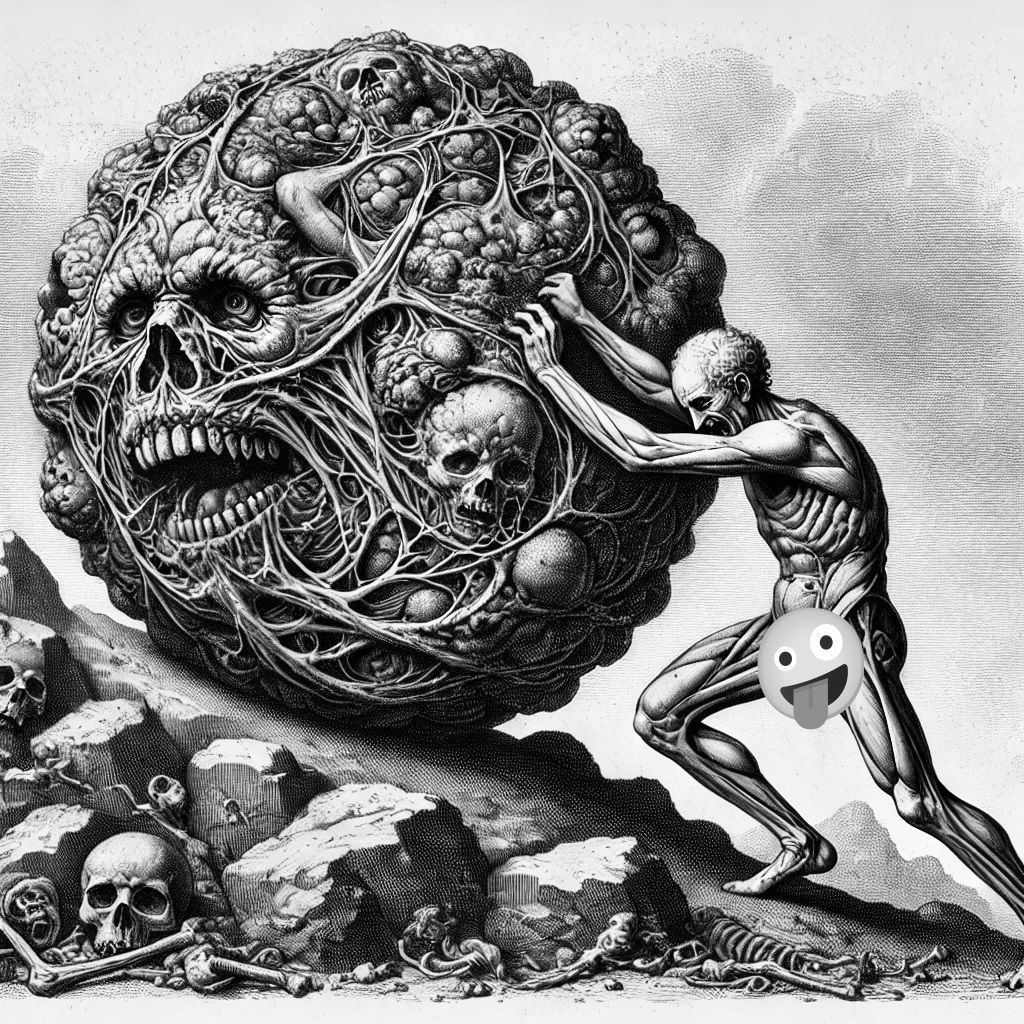Finally! An ad client I can truly get behind: Mood Gummies! Over the last few years, I’ve fallen in love with THC gummies as a way to get an extra-good night’s sleep: Pop one half-an-hour before bed, and I wake up the next morning ultra-refreshed. And apparently, Mood Gummies sells these things. In fact, I just bought some of their blackberry-flavored sleepytime gummies. Anyway, click on their ad and, like, maybe buy some gummies?
By early October, the movie Inside Out 2 had made nearly $1.7 billion around the world, making it the highest-grossing animated movie—and one of the highest-grossing movies flat-out—of all time. Rotten Tomatoes ranked it as 90% fresh, meaning the critics overwhelmingly approved, and the site’s Popcornmeter, a measure of audience sentiment, scored 95%. In short, everyone loved Inside Out 2.
Well, not everyone, of course. When I finally got around to watching it on Disney+, long after my daughter Sandy had seen it with her middle-school class, I couldn’t sit through it. I’d liked the first Inside Out, especially the elegant clarity of the emotions depicted by Amy Poehler (Joy), Phyllis Smith (Sadness), Bill Hader (Fear), Lewis Black (Anger), and Mindy Kaling (Disgust). They made sense to me in an elemental way, as did the outer-world plot about a girl moving to a new town and questioning her place in it.
The new Inside Out felt messy and murky, with too many new and ill-defined emotions (Ennui, srsly?) and an external, highly relatable plot about [checks notes] friendships at ice-hockey camp? I wanted to like it. I didn’t want to dismiss it as cringe. But a third of the way through, I just tuned out. I got distracted by something else in the house, hit pause, and never returned. But I’m sure everything turned out fine in the end, and everyone learned a valuable lesson.
Me, I didn’t care that much—it’s just a movie!—but one of my friends, N., says he hated Inside Out 2. And so, of course, he found himself at dinner once with a psychologist who absolutely loved it: “Greatest movie she’d ever seen,” he texted me. Naturally, their disagreement got ugly. But I’m sure everything turned out fine in the end, and everyone learned a valuable lesson.
Is Inside Out 2 Good or Bad?
Based on the critical reception, I’m willing to admit that Inside Out 2 may, in fact, be a good movie. Could 90% of critics possibly be wrong? But frankly, that’s not the point of this essay. The point of this essay is that most of us evaluate things in our lives—movies, music, food, art, writing, clothing, and so on—in an overly simplistic way. That is, we think the things we like are good, and the things we don’t like are bad. And we think anyone who thinks otherwise is simply and absolutely wrong.
This is simply and absolutely wrong.
Now’s the time to read the ad and click the link, so I can afford to buy more gummies! More essay afterwards…
This cannabis startup pioneered “rapid onset” gummies
Most people prefer to smoke cannabis but that isn’t an option if you’re at work or in public.
That’s why we were so excited when we found out about Mood’s new Rapid Onset THC Gummies. They can take effect in as little as 5 minutes without the need for a lighter, lingering smells or any coughing.
Nobody will ever know you’re enjoying some THC.
We recommend you try them out because they offer a 100% money-back guarantee. And for a limited time, you can receive 20% off with code FIRST20.
I can see why most people think this way. If we like an oil painting, say, or a hot dog, or an oil painting of a hot dog, then it seems only natural we would think they’re good (especially the hot dog). And because they’re good, we tend to assume all, or most, other people would feel the same way. This goes for the flip side: If we don’t like something, it must be bad. My wife, Jean, doesn’t like beets or durian, for example, and while she understands there exist people—like, say, her own husband—who do like both beets and durian (though not together), Jean’s default instinct is to assume that no one likes them. Why would they? Beets and durian are bad, after all.
But that, as the kids say, is yucking my yum. Obviously, we humans can never agree on anything. And we’re mostly okay with that: You like country music, I like hip-hop, and while we can argue about Beyoncé and Post Malone, we understand: It takes different strokes to move the world.
The real problem comes in when we connect our preferences to the concepts of good and bad because then we’re not just talking opinion, we’re classifying quality. We’re judging—and we’re judging not just the object but the subject, too. Because who could like something bad, or hate something good? Only someone who has something deeply wrong in their soul, I guess.
Or flip that around: What if the wrong person is you? What if you adore a TV show that most others clearly detest (or that Netflix declines to renew)? Does that mean you like terrible things, or conversely that the mass audience prefers terrible things?
The way to resolve this—the approach I’ve taken for the last couple of decades—is to separate like and hate from good and bad entirely. Here, I made you a handy chart to explain:

Yes, this is a very math-nerd thing to have made.
I shouldn’t have to explain the chart, but I will! Take anything—Chappell Roan’s appearance on SNL, Elizabethan theater, Ample Hills ice cream—and place it on the chart. If you like it, it goes more on the right, and if you don’t, more on the left. Meh? In the middle. That’s easy.
Now, is it good or bad? This is more complicated. This is where we start to use our critical faculties: How does this measure up, in a more objective sense, in the realm of its genre? Did Chappell Roan sing on key, remember her lines, emote and strut and fulfill our general expectations for an SNL performer? We can certainly argue about the answer, but at least we’re arguing against a commonly held set of criteria for what counts as good or bad, separate from how we feel about them.
You Should Do This
This is the way to think, and it’s liberating! It allows you to like what everyone agrees is trash (that’s the bottom-right quadrant, Guilty Pleasures), while letting you escape the overwhelming pressure to love the cultural objects that everyone agrees are wonderful (the top-left quadrant, a.k.a. Unpopular Opinions). And once you’re free, you can think more clearly about what you like or hate and why you feel that way. This is a recipe, I like to image, for getting along with the world, for finding common ground while respecting a diversity of opinion, and I wish everyone would use this framework. If you don’t, you’re bad and I hate you.
Look, I don’t really expect this to happen, certainly not in the broad world of cultural criticism. (Okay, yes, there’s the New York Magazine “Approval Matrix,” but its axes—highbrow/lowbrow and brilliant/despicable—are both objective, while mine is about balancing the subjective with the objective.) Reviews aren’t about to feature little Cartesian planes at the end where the critic admits that they liked the gummy pasta and overpriced wine list, or that Martin Scorsese’s final masterpiece is definitively genius but put the critic to sleep. Professionals have to maintain the illusion that their opinions are objective reality, because that’s their job. It’s wrong, but it’s understandable.
The rest of us, though, don’t have to play like that. We can adjust our thinking to allow for gradations and subtleties that frighten the pros, but that’s their problem. Maybe we’ll discover we’re all masochists and cranks, loving the crappy and hating the awesome, and maybe we’ll wind up redefining what’s good and bad in our culture. I can live with that.
There is, of course, one exception: this newsletter. Whether you love it or hate it, think it’s reasonably high quality or abysmal dreck, I don’t care. As long as you hit Like! and Subscribe! and click the ad link on occasion, I know one thing for sure: I love you and you are most definitely, without any question whatsoever, the best.



